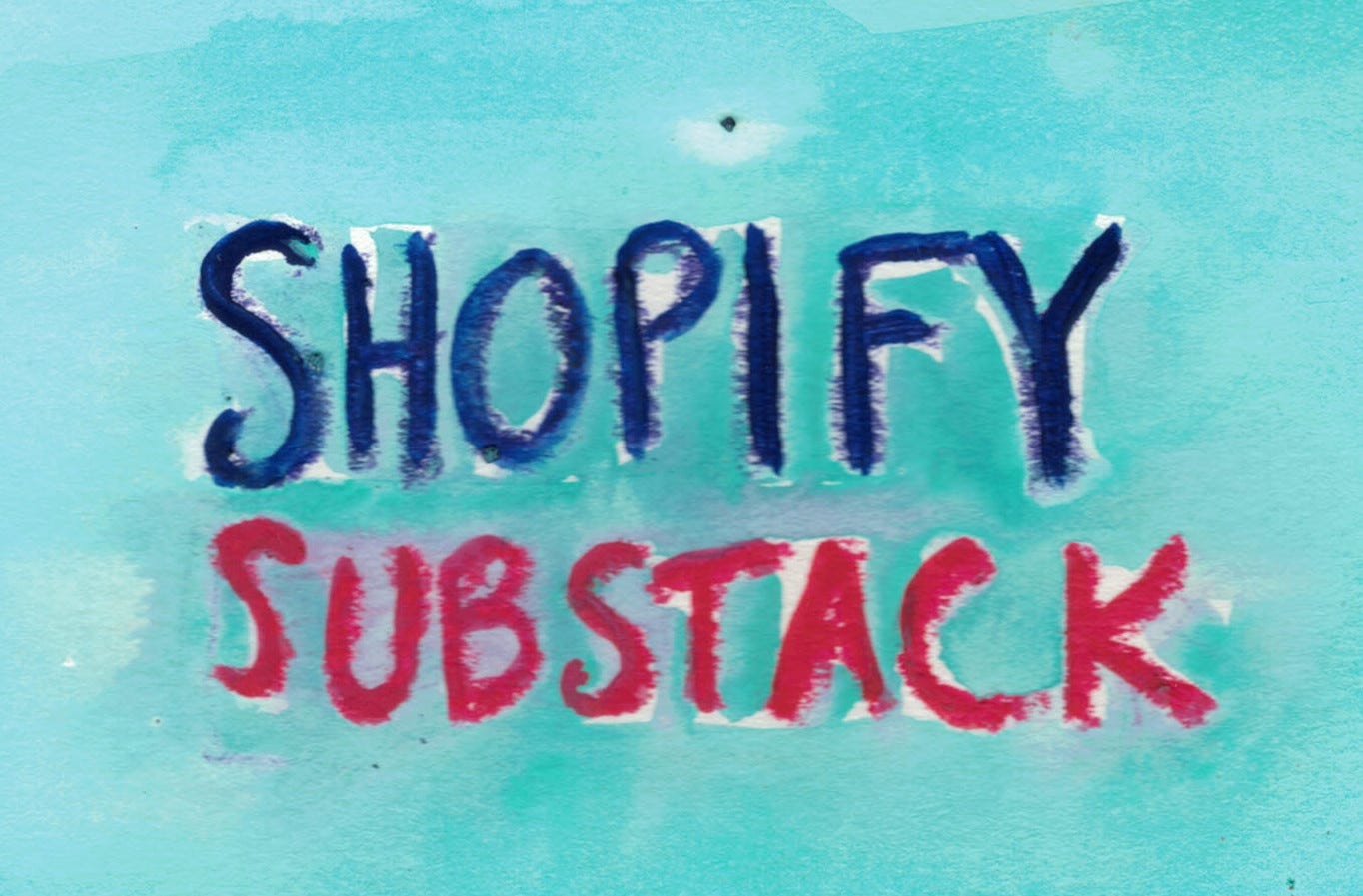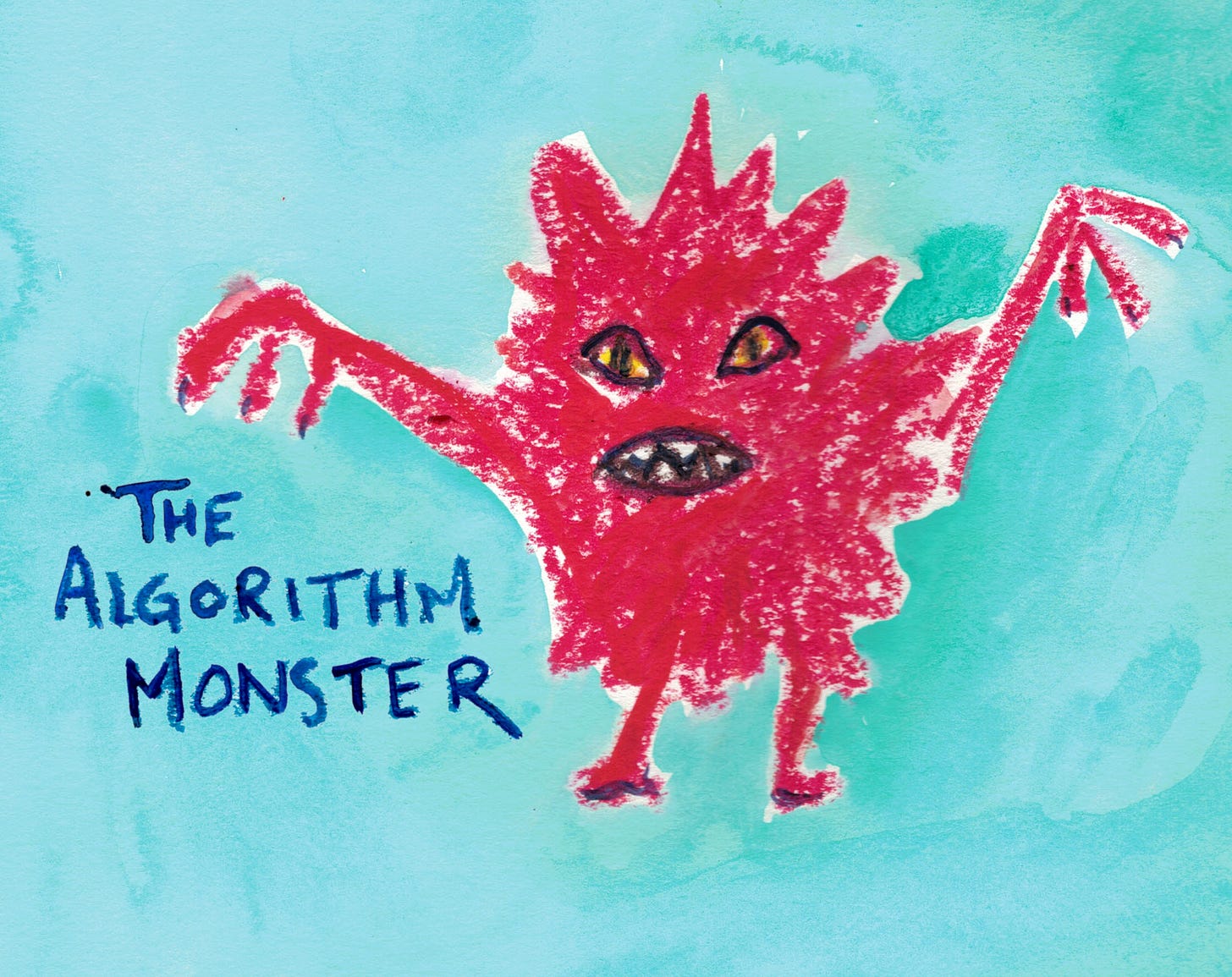SHOPIFY x SUBSTACK
What works, what doesn't, and what I decided to do
As someone who thinks of herself as a writer first and artist second, I was delighted to learn about Substack. If Substack has a target demographic, I’m pretty sure I’m right at the center of the bullseye. Not only that, but the others I’m hoping to connect with will be in the center couple of rings of that bullseye. Hooray!
However. In reality I’m an artist first and a writer second, and as much as I’d love to I don’t have time to write all day, interact with other writers, build a community of pats-on-the-back, and so on. And I don’t have time to do how-to art tutorials, interview other creatives, or provide tips for success in a changing marketplace, and so on. There’s nothing that wouldn’t take copious amounts of time that I can create to be an irresistible value proposition for a paid subscription, especially that needs to be created and posted with a fixed, regular schedule.
So I’m not at the moment interested in soliciting paid subscriptions. I just want to write fun little essays to provide a larger context for the art itself. In my case, with my literary background, my art has a strong focus on character, history, and the imagination, and so I really enjoy writing about the different bits and pieces that go into what I do. I thought others might enjoy it too, but how do I go about finding the right readers?
I have a shop powered by Shopify that takes care of all my shop-front needs, and I have an Instagram account for most of my marketing needs. Most. But that Instagram algorithm is, as my husband likes to say, an abusive dad that will one day come home and give you a beating and the next day bring you home a bicycle. Not fair!
And the Shopify native newsletter whose subscriber count I worked so hard to increase is likewise victim to the various email inbox algorithm monsters which, now that I’ve reached a certain level of success, relegate me to the Promotions tab and Spam folder. Even after paying for emails to be sent. Not fair!
So diversification is indeed key, and Substack seemed to be the perfect solution. But I’ve run into issues.
Your site won’t keep the SEO
First, SEO. One of the main reasons to write a blog or long-form content is to plump up the keywords occurring rather naturally in your website’s code, thereby increasing its ranking in Google searches. If you write and publish your content exclusively on Substack, you won’t benefit from the SEO. They will.
Even if you change the URL to a subdomain, your site won’t keep the SEO
There’s a slight workaround, which involves creating a subdomain on your website and redirecting your Substack newsletter there. It costs $50 and requires coding, but you can do it. It took me all morning, but I did it. My new Substack URL is thestoriedlife.susannahcarson.com, not something to do with Substack. However, because this is a subdomain, those keywords STILL don’t count to my main site’s SEO, thereby defeating one of the reasons for writing long-form content in the first place.
Integrating your current newsletter list is not as straightforward as it seems
Apparently I can import all my current newsletter subscribers over to Substack. But then what? What happens when new people subscribe to my newsletter?
The embedded Substack sign-up form is ugly
Well, I can embed the Substack code into a page on my website. The only problem is that even though I selected the same brand palette, the Substack fonts are their own, the formatting is their own, and it comes with their policies and watermark. It does not look good. For another type of business, it might be perfectly fine. But for an artist with an eye for detail and a stomach-ache at the thought of the most minor inconsistencies?
The workaround embed code for the Substack sign-up form doesn’t work
I tried a free Substack sign-up embed code generator (substackapi.com), which was touted to be a way to simplify the sign-up form. It worked. Kinda. It was pared down, but for some reason I couldn’t center it, and I couldn’t write what I needed to write above it. Then, when I tried it out, it said a confirmation email had been sent, but no confirmation email was ever sent, and then it turned out that the sign-up had gone through anyway.
I could probably make it work by spending another couple of hours learning coding, but again, I’m an artist, not a coder, and at a certain point it’s the principle of the whole thing. This should be easy!
There’s no way to have the check-out newsletter opt-in redirect to Substack
And furthermore, even if I do figure out how to have my website’s sign-up page send harvested email addresses to the new Substack email list, what about the newsletter opt-in on the Shopify check-out page? There’s NO WAY I’ll ever be able to figure out how to have those emails head over to Substack, if it’s even possible.
And even more furthermore, my husband and I are a little confused about the emails we have for customers that don’t have to do with the newsletter and are essential for order-related business. We don’t want to meddle too much with any native Shopify email collection for fear of not being able to contact customers for better service.
There’s no way to automate based on website interactions
Oh, and automations. I’m not too keen on salesy automations, but a couple can be helpful, for instance abandoned check-out emails have been helpful to know that the so-called calculated shipping has occasionally gone wonky for multiple item and overseas orders. And sometimes I just want to send out a quick note that I’m having a flash sale, which would be inappropriate to the culture of Substack long-form newsletters.
There’s no way to have subscribers subscribed to both
So what about importing the current subscriber list over to Substack, keeping the native Shopify newsletter sign-ups on my website, and manually bringing over new newsletter subscribers to double enroll them onto Substack? Well, it’s a lot of work, but I think it could be done. However, if I double enroll subscribers, what happens when someone wants to unsubscribe? They’ll unsubscribe from one or the other, but not both (as far as I know, there’s no way of keeping track of new *un*subscribers on either platform), and so they’ll still be subscribed to one, and they’ll be confused and angry and be turned off from me and my content even more.
The Substack newsletter can also end up in Promotions and Spam anyway
And one more thing: Substack is subject to the same inbox algorithm monsters!
Our conclusion is that Substack is NOT a replacement for native Shopify email newsletters. The tech isn’t up to it. And it just doesn’t serve the same basic purpose.
IN A DREAM WORLD…
Substack integrates seamlessly with Shopify, with reliable email collection, customizable interface, newsletter automation, and archiving as a blog that appears simultaneously on the main domain and on Substack. Sigh…
HERE’S WHAT I’M GOING TO DO
For the time being I’m going to do a triple copy-and-paste:
to my website’s blog for engaging site content and naturally occurring SEO
to my native Shopify newsletter
to my Substack feed
Given that Substack’s goal is to attract people over to the larger Substack culture, and my goal is to attract people over to my website, there’s an inherent conflict of interests - much as there is with any social media outlet or ecommerce marketplace!
I’m still excited about Substack, though. I really am the bulleseye target demographic. So although I was hoping to integrate with my existing architecture, I guess I’ll just have to see if I can grow, slowly, patiently, and independently, over here on Substack.





would love to hear if you ever figure out the integration! I'm trying to figure out how I can have a "sign up for the newsletter" embed on my shopify site that subscribes them for my substack ... why is it so hard :(
This is so helpful. Thank you!